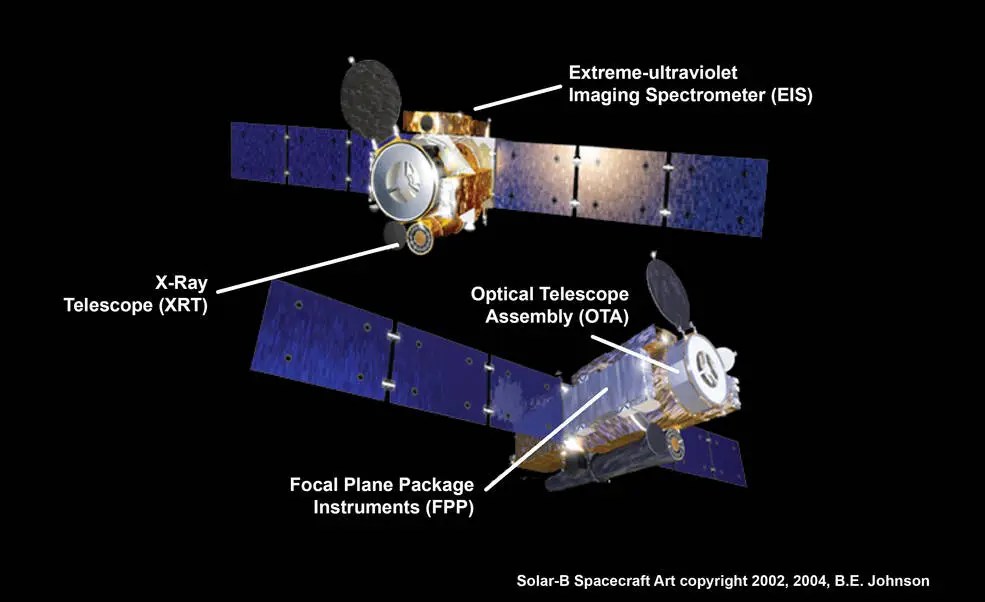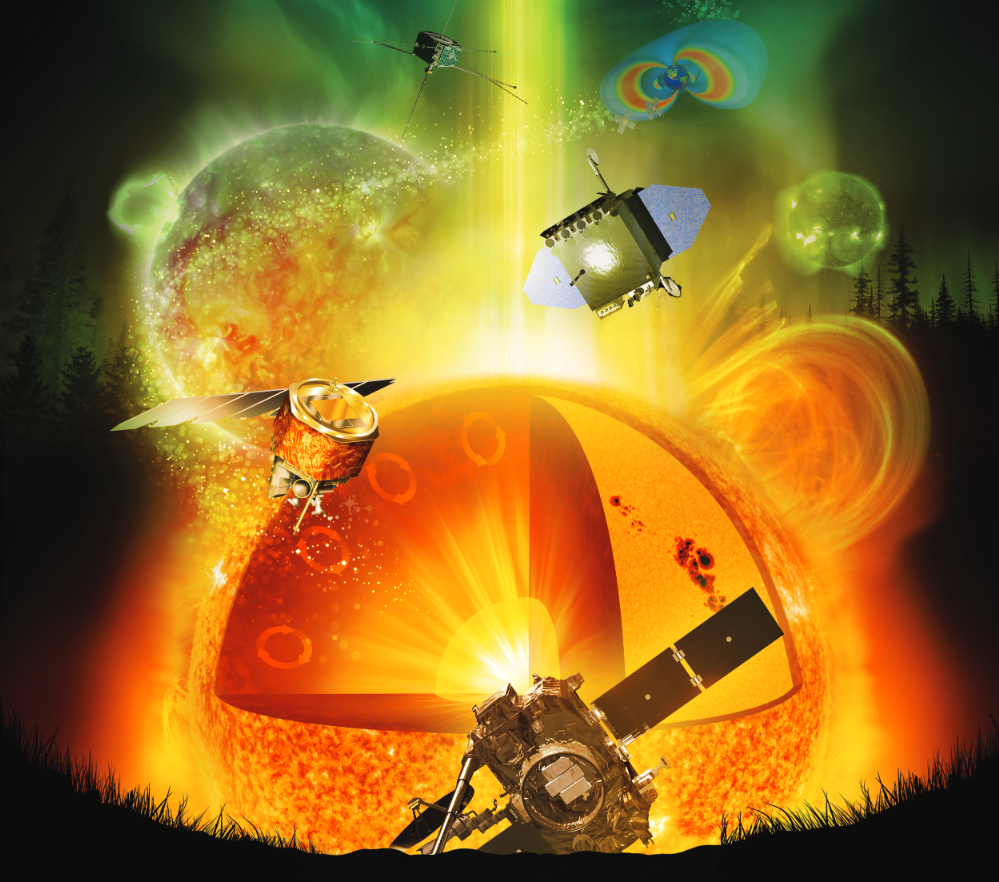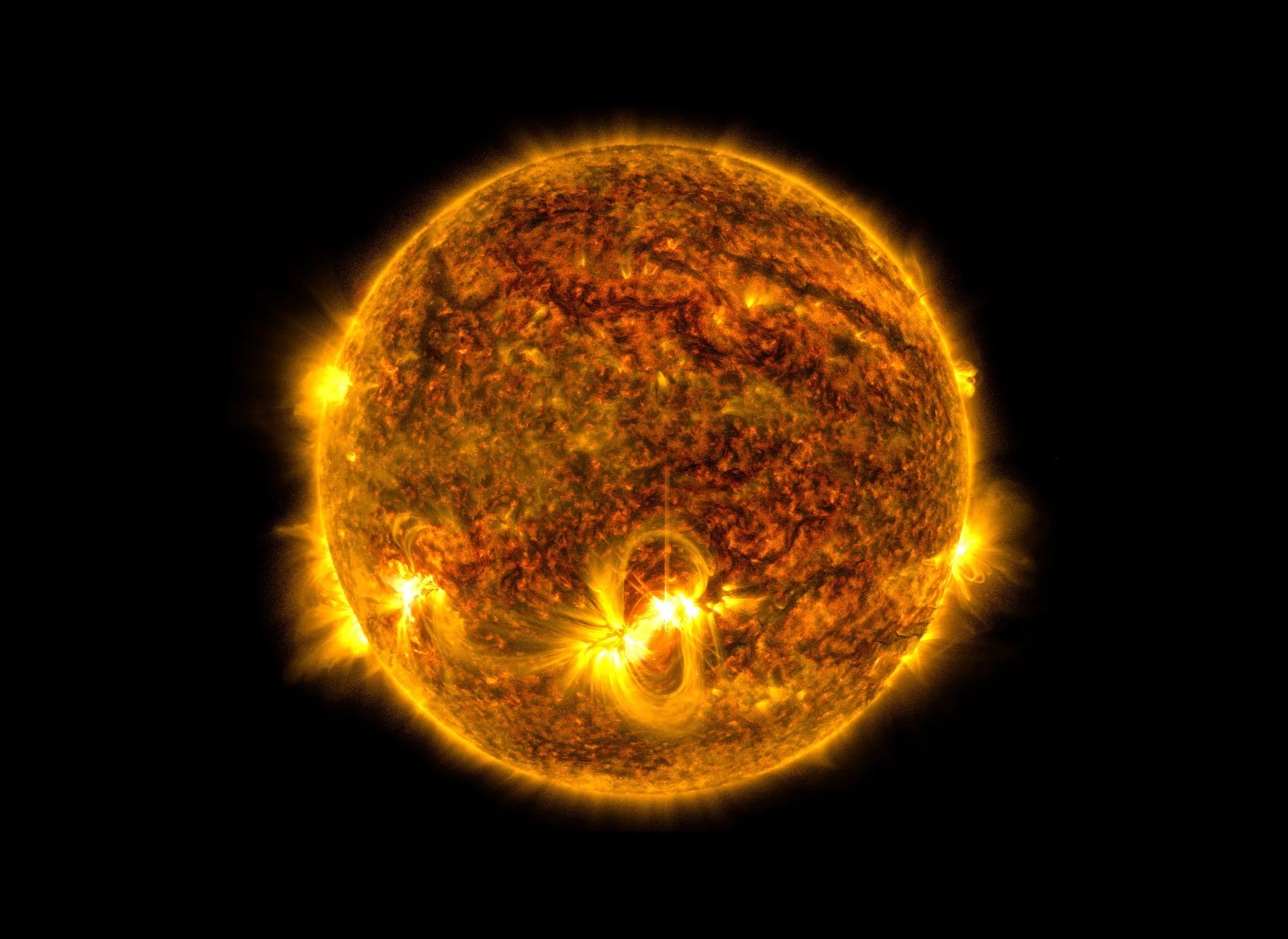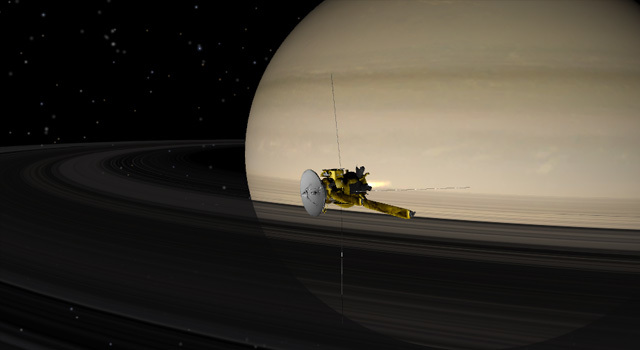Hinode’s Solar Optical Telescope is the first spaceborne instrument to measure the strength and direction of the Sun’s magnetic field on the Sun’s surface, the photosphere. Combined with two other Hinode instruments, the EUV imaging spectrometer, or EIS, and the X-ray/EUV telescope, or XRT, the mission is designed to understand the causes of eruptions in the solar atmosphere and relate those eruptions to the intense heating of the corona and the mechanisms that drive the constant out ow of solar radiation, the solar wind.
Hinode lies in a Sun-synchronous orbit around Earth at an altitude of nearly 400 miles (a little under 650 km). Its orbit allows Hinode to observe the Sun continuously for nine months at a time. During the summer (in the northern hemisphere) Hinode experiences an “eclipse season” during which the Sun is eclipsed by Earth for a maximum of ten minutes in each 98-minute orbit.
Launched on a Japanese M-V rocket out of Kagoshima, Japan, on September 23, 2006, Hinode is led by the Japan Aerospace Exploration Agency, or JAXA. The Hinode mission is a collaboration between the space agencies of Japan, the United States, the United Kingdom and Europe. Hinode is expected to continue into 2022 after being extended in 2020.
The Science of Hinode
Hinode focuses on three main questions about the Sun.
How is energy from magnetic fields near the solar surface, the photosphere, transmitted into the corona?
Scientists have studied the Sun for over 100 years, and although we have learned a lot about the major changes that take place on its surface and upper atmosphere, we still don't have enough information about how various forms of energy move from place to place. One of the most important forms of stored energy is in the magnetic fields, which can be concentrated and tangled up. When this energy is released, it can heat local gases to 100s of thousands of degrees or more. Scientists want to know exactly how this stored energy is released, and in what forms it makes its way upward into the solar corona.
How does this energy cause changes in the structure and interactions that take place in the corona?
The release of magnetic energy is a complex process that involves changing one magnetic field shape into another, like taffy being pulled. Scientists want to know how magnetic fields change their shape in an explosive way to create solar flares, and how these changes alter the solar atmosphere and corona.
How do these changes affect the environment of interplanetary space?
Earth and the planets in our solar system orbit the Sun inside the Sun's outer atmosphere. During solar eclipses we see the brightest part of this atmosphere -- the corona. As it moves farther from the Sun, this expanding atmosphere becomes more dilute and we call it the solar wind. The entire atmosphere extends well beyond the orbit of Neptune and we call it the heliosphere. Scientists want to know how magnetic changes near the surface of the Sun affect the heliosphere. Because Earth interacts with the solar wind and heliosphere, and severe changes in this dilute atmosphere can cause satellite outages and electrical power blackouts, scientists want to know exactly how all of its various parts work together as a system.
Hinode Instruments
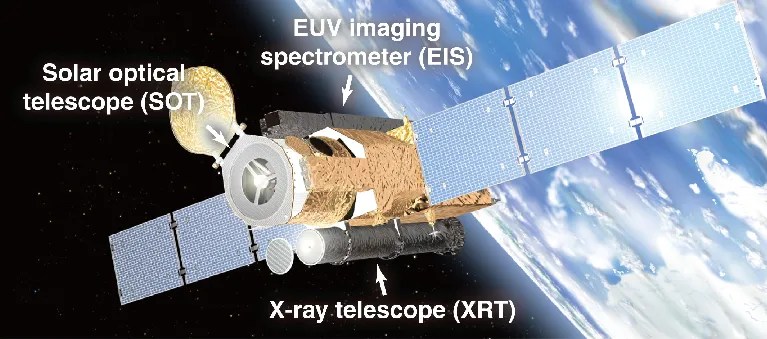
By studying the Sun's magnetic field, scientists hope to shed new light on explosive solar activity that can interfere with satellite communications, electric power transmission grids, and even threaten astronauts on the way to or working on the surface of the Moon. Hinode carries three scientific instruments to help identify the magnetic field configurations that lead to these explosive energy releases. Scientists use the information from these instruments to predict when these events may occur.
The Solar Optical Telescope
This suite of instruments precisely measures small changes in the Sun's magnetic field, including how these changes coincide with dynamic events seen in the Sun's corona — its hot, million-degree outer atmosphere which extends millions of miles into space. The Solar Optical Telescope was developed by the National Astronomical Observatory of Japan, with the telescope’s Focal Plane Package developed by Lockheed Martin in Palo Alto, Calif., and the High-Altitude Observatory in Boulder, Colo. NASA is responsible for the design and development of the Focal Plane Package, and Dr. Ted Tarbell of Lockheed Martin Advanced Technology Center is the principal investigator.
The X-ray Telescope
The X-ray Telescope captures X-ray images of the Sun's corona. The corona is the spawning ground for the solar flares and coronal mass ejections that dominate the space between the Sun and Earth. These phenomena are powered by the Sun's magnetic field. By combining observations by Hinode's optical and X-ray telescopes, scientists study how changes in the Sun’s magnetic field trigger these explosive solar events. This telescope was developed by the Smithsonian Astrophysical Observatory in Cambridge, Mass., and the Japan Aerospace Exploration Agency. The Smithsonian Astrophysical Observatory provided the telescope optics, filters and structure, while the Japan Aerospace Exploration Agency provided the charge-coupled device, or CCD, camera. Dr. Ed DeLuca of the Smithsonian Astrophysical Observatory is the principal investigator.
The Extreme Ultraviolet Imaging Spectrometer
Although capable of generating images, the primary function of Extreme Ultraviolet Imaging Package is to measure the flow velocity, or speed of solar particles, and diagnose the temperature and density of solar plasma — the ionized gas that surrounds the Sun, its corona and beyond. The Extreme Ultraviolet Imaging Package provides a crucial link between the other two instruments because it can measure the layers that separate the photosphere from the corona — an area known as the chromosphere and the chromosphere-corona transition. The spectrometer was developed by the Mullard Space Science Laboratory of the University College London in the United Kingdom and the Naval Research Laboratory in Washington. Major spectrometer elements were developed in the United Kingdom under the direction of Mullard's Professor Leonard Culhane, who is the principal investigator for the Particle Physics and Astronomy Research Council who is funding the investigation in the United Kingdom. Supporting Culhane in the development of the instrument’s optical systems and with the scientific analysis is the principal investigator, Dr. George Doschek of the Naval Research Laboratory.
Led by the Japan Aerospace Exploration Agency (JAXA), the Hinode mission is a collaboration between the space agencies of Japan, the United States, the United Kingdom and Europe. NASA helped in the development, funding and assembly of the spacecraft's three science instruments. Hinode is part of the Solar Terrestrial Probes (STP) Program within the Heliophysics Division of NASA's Science Mission Directorate in Washington. The Solar Terrestrial Probes Program is managed at NASA's Goddard Space Flight Center in Greenbelt, Md. NASA's Marshall Space Flight Center in Huntsville, Ala., managed the development of instrument components provided by NASA, with additional support by academia and industry.
Hinode Spacecraft
